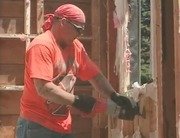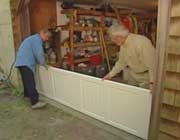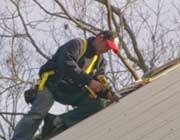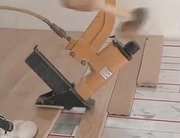Hi I'm Bob Vila.
Welcome to the show.
Our edition is for long and today, we're putting up some beautiful cedar siding on the front under the porch.
Also, inside we're installing a brand new state of the art boiler, that's going to do a lot of different tasks.
We're insulating using cellulous blown in insulation.
Inside we're putting in a fireplace and working on the drywall and putting in wood port doors.
Stick around, it is good to have you with us.
Now, the front of the house is gonna have a big farmer's porch with a roof over.
all the way cross the whole width to the house, perfect rocking cheers, and we are using western red cedar to trim everything out.
Now this is western red cedar 2 by six, which we will use for decking.
And Howard is back there starting to put some of the siding in place but Peter Lang is with us from the Western Ridge Cedar Lumber Association.
Sorry.
How are you Peter?
Hello Bob.
Sorry to bring such a cold windy day, but let's talk a little bit about the reasons why western red cedar is such a good choice for exterior applications.
Well there's several reasons.
First of all in applications such as siding, it is very exciting, it's a very visible part of the house, so therefore the look is very important and western red cedar is renowned for it's natural beauties.
So it will certainly greatly enhance the look of the house, the curb appeal.
Yeah, in this case we're using tongued and grooved with a v in each one right?
Yes.
The product is a 1x6 tongue and groove.
Tongue and groove.
It is a potentially a reversable.
One of the more /versatile cedar patterns in that it is a potentially reversible product.
You could put rough sawed part out?
You could put rough sawed part out or the smooth faced, depending on the look that you want to achieve it.
And of course you could use it horizontally or
Or vertically.
That's correct and of course even in the ceiling applications.
In the ceiling applications
In the ceiling applications at times.
Yeah and Peter is western red cedar consider a green material?
Cedar is very definitely a green building material.
It is for several reasons.
First of all, it's one of the few building materials that are naturally renewable, comes from a renewable resource.
Also it is harvested in a sustainable manner from well managed forests, many of the forests, many of the companies To our engaged in the business our harvesting from Certified forest third party certification systems such as SFC and CSA to ensure the highest standards of forestry are being practiced.
In addition, cedar there of course is recyclable material.
It's biodegradable.
Sure.
But I was telling you from a carpenters perspective its a dream to work with.
It absolutely is.
Thanks Peter.
Thank you, thank you
Ok.
Tim Cutler is with us now from T.J.'s Plumbing and we're listening to the the Weizmann we've got three different kind of things happening here, right?
Yes.
can you take us through it I can we have a boiler which is heating our domestic hot water.
Its also heating our radiant heating system and its running up hydro wave of heating point here All right.
The hydro air system is a air handler with a hot water coil inside it.
Right.
So the water gets heated by the boiler, sent through the coil, and then sends warm air out through the building.
Yeah, and that primarily is for the existing older part of the house, right?
Exactly.
Yeah.
Exactly.
And then what about domestic hot water needs, for the showers and the kitchen, etc?
The showers and the kitchen get fed by a 79-gallon indirect domestic hot water dual-coil tank, okay?
The bottom coil gets fed by our solar system, which has Viessmann evacuated tubes, okay?
How many of them?
There are thirty on the roof.
This is a copper fin, you can actually see it right here.
There you go.
What happens is it has alcohol inside this, it has a very low boiling point.
Right.
When we boil, it transfers the BTUs to this bulb, and we pick it up and send it through this lower coil, which heats our domestic hot water.
OK, and then on the other side of the room we're going to talk to your colleague about the PEX part of it, right?
Exactly.
All right.
Thanks Tim.
Then going from the old part of the basement to the new addition what we did was we had a concrete cutter come in to provide this opening.
And over here Bill Sloan is here from Viega.
Now the heating in the new addition is actually up in the slab, right?
Yes, these pipes run up in these fire retardant pipes from the slab.
And these are all PEX?
These are all PEX tubing.
Right, and then Viega is manufacturing the manifold?
Yes, yes.
And this copper system here also which is ProPress system, which is both the supply and return pipes.
You can feel the hot water going up and then, you can feel the return pipes...
Returning cooled off.
...cooled off.
Right exactly.
Oh yes, you totally can Now what kind of joints are all of these?
These are pro press joints, Bob.
Pro press.
Pro press.
It's a copper system, that's been over in Europe for over 25 years.
And it doesn't require any soldering ?
No solder, no flux, no torch.
Have you got a sample?
Yes I do.
This is a pro press fitting.
Basically you can press from half to four inch kale or in copper.
Soft copper from 1/2 inch and a 1/4.
And then there is like a black something in there right?
That is an EPDM saline element commonly referred to as an O ring.
An O ring?
Yeah.
Ok.
Excellent.
So this is all done right?
Yes it is.
I wonder why it's so cold in here?
Thanks a lot.
Thank you.






